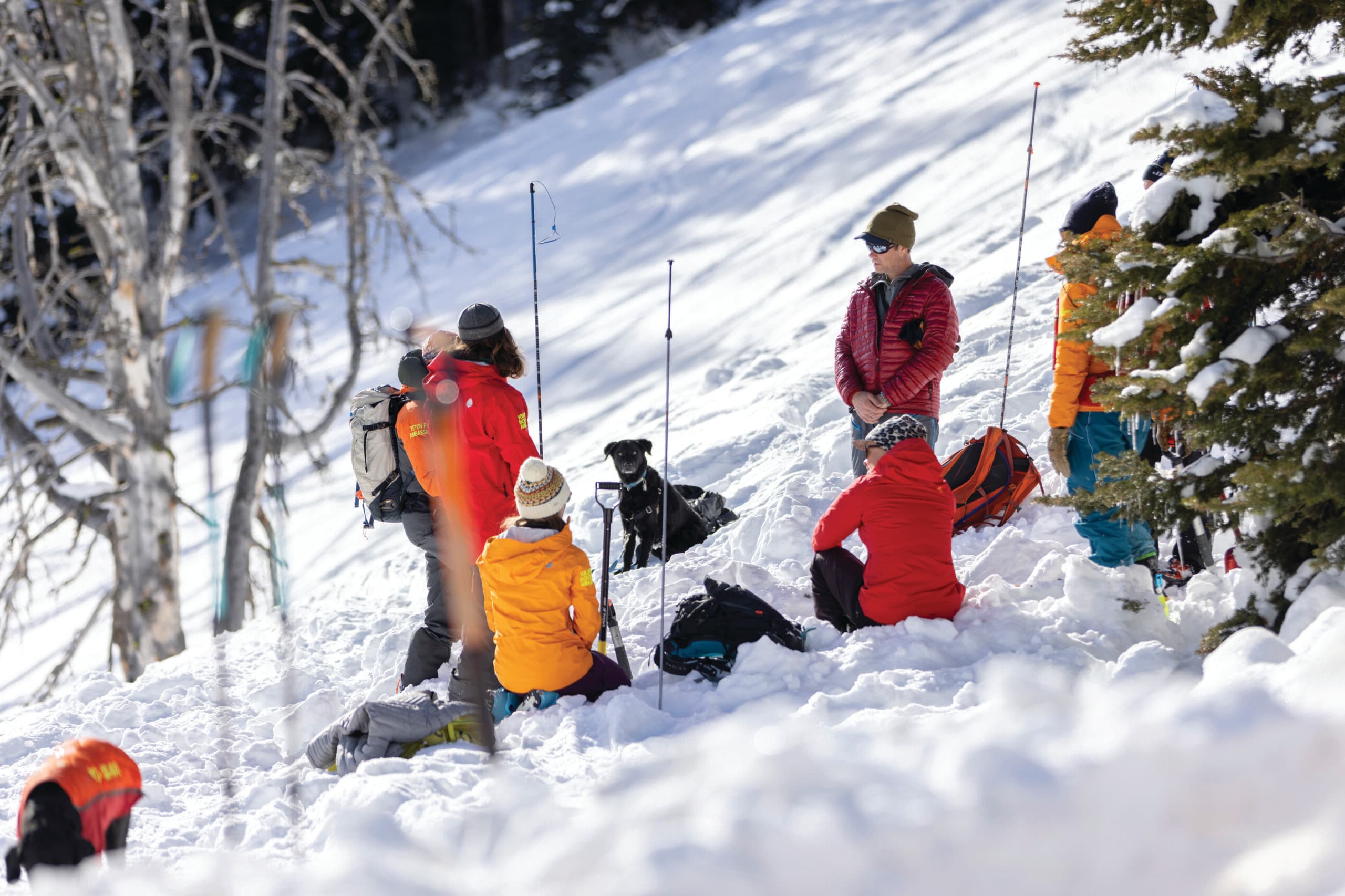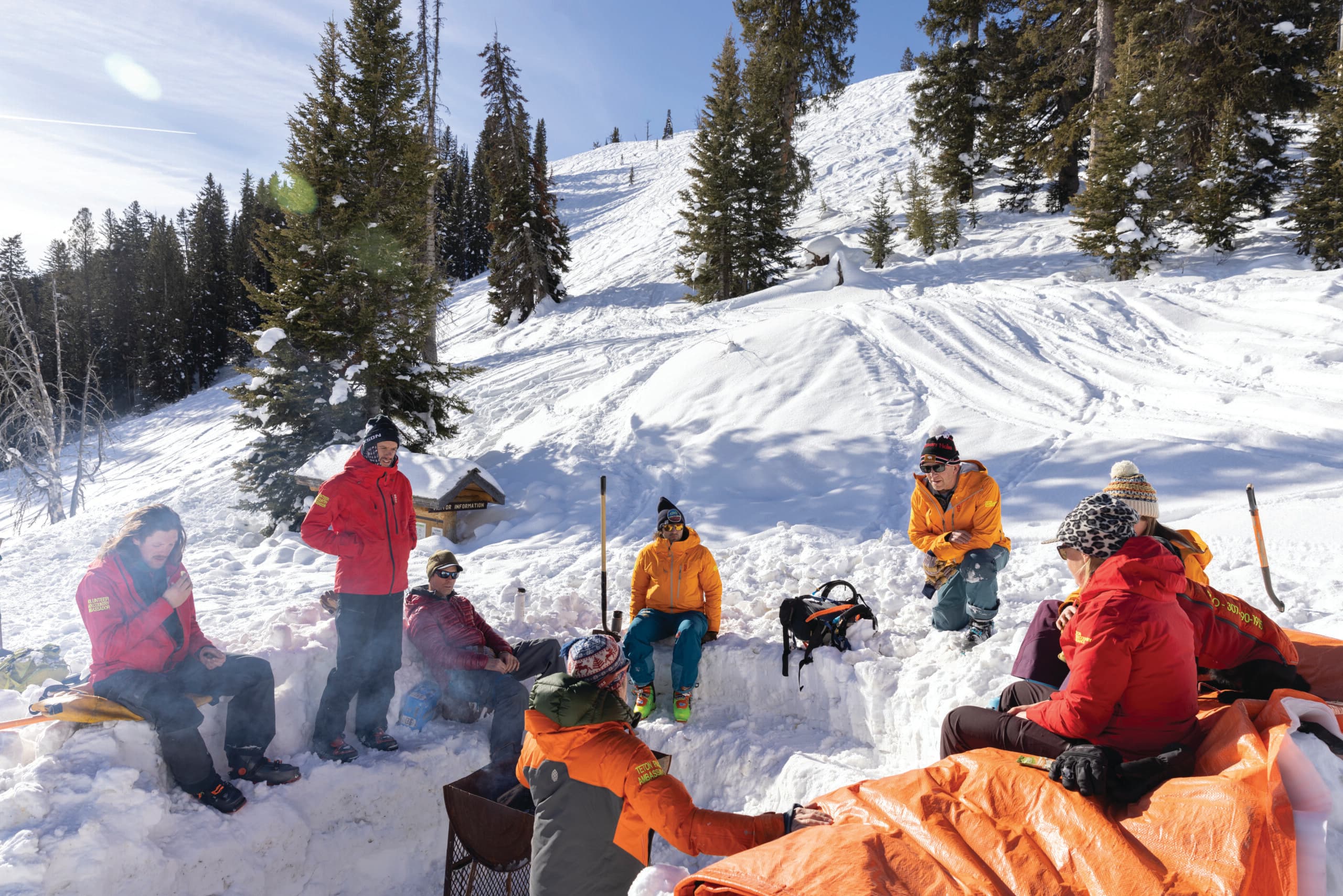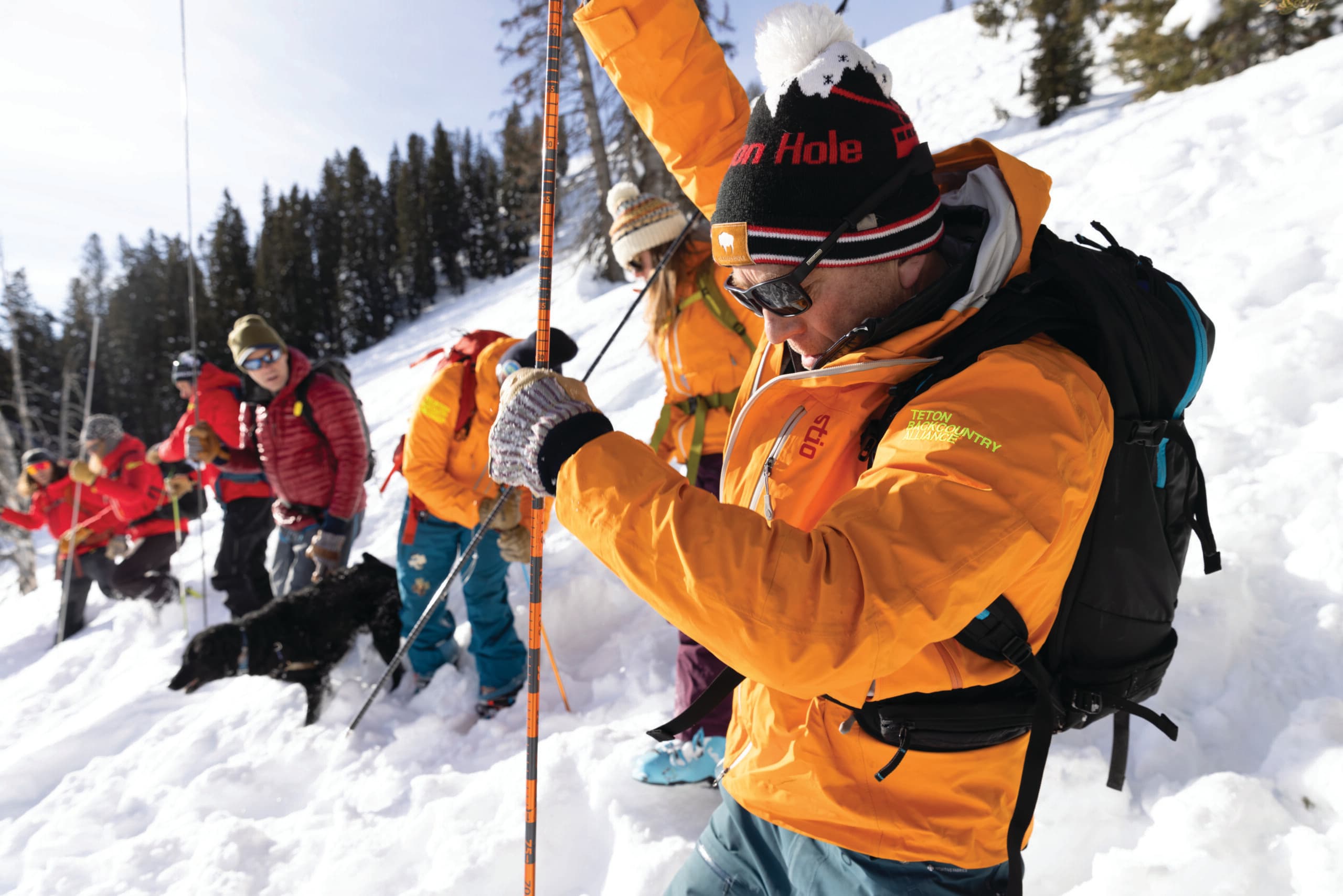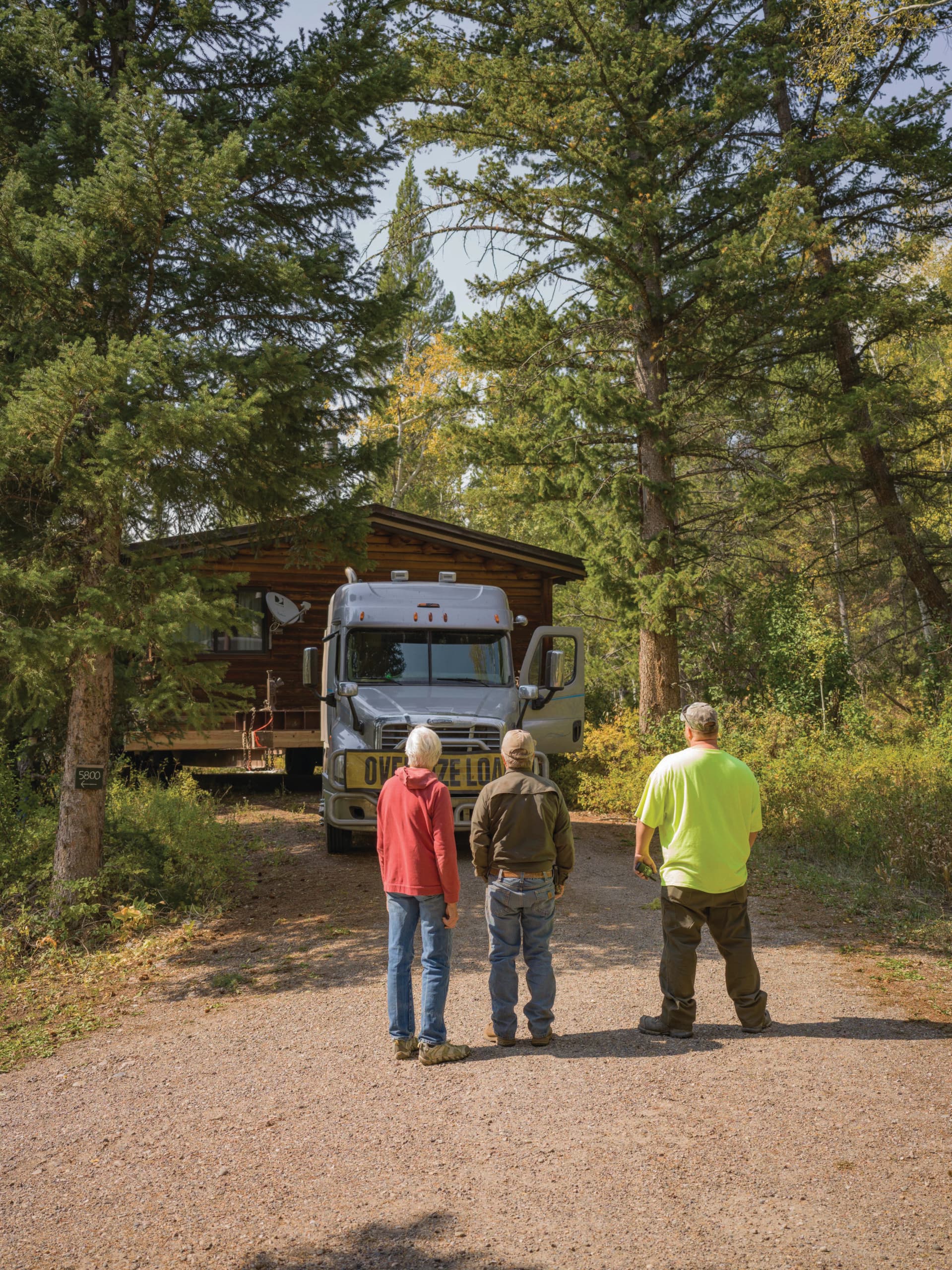Boots on the Ground

Backcountry ambassadors promote safety, education, and responsible use
It’s just after sunrise on a blustery winter morning on Teton Pass. A foot of snow is in the forecast, and flakes are already flying as a line of commuters’ vehicles make their way from Teton Valley to Jackson Hole.
Another line of cars forms to the side—skiers and snowboarders eager to find some fresh powder. But first, they need to find a parking space. As they drink coffee and eat breakfast burritos, awaiting a space to open, a volunteer in a bright Teton Backcountry Alliance Volunteer jacket walks by, chatting about conditions and encouraging people to park tightly to squeeze in more cars. The volunteer is one of Teton Backcountry Alliance’s team of volunteer backcountry ambassadors, who are working to help things run smoothly—and safely—in the backcountry.
Teton Pass is a popular backcountry skiing and snowboarding access spot, and the highway running through it is the main artery connecting Teton Valley with Jackson Hole. Every day, thousands of commuters use the route to get to and from work, as well as to access shopping, medical services, and more. Avalanches have stormed onto the roadway a number of times in recent years, sometimes entrapping vehicles. In 2019, an avalanche brought several feet of debris down across the roadway during the morning commute, causing a closure that lasted until 5pm. Many speculated it was skier triggered.
Closures of Teton Pass Highway 22 occur during the winter because of slides and, in other cases, for avalanche mitigation control work. Complicating this work is the need to first clear the area of backcountry skiers and riders.
Conflict between backcountry users and commuters—as well as conflict among backcountry users over things like parking spaces—has led to backcountry users working together to find solutions. In 2017, the Teton Backcountry Alliance was launched “to promote public safety, community, stewardship, and sustainable access for Teton-area winter backcountry users,” according to the organization’s website.
“One of the main issues our little organization recognized as critical was continuing to maintain access to Teton Pass, with that potentially being imperiled as a consequence of a number of safety issues—the consequence of more and more people going to the pass and an increase in backcountry use,” says Gary Kofinas, chair of the Teton Backcountry Alliance steering committee. “Teton Pass is spectacular winter backcountry terrain, some of the best in North America. And it’s very accessible, and so that combination draws a lot of people in.”
He says their initial concerns included parking lot congestion, dogs (see page 74 for tips on how to safely adventure with your pup), and people skiing treacherous routes on days with considerable (or higher) avalanche danger. “We worried that a slide could kill another skier or hit a car,” Gary says.

Longtime Teton Pass Ambassador Jay Pistono trains a group of new ambassador volunteers atop Teton Pass on a sunny Sunday in January. Photo by David Stubbs

Longtime Teton Pass Ambassador Jay Pistono trains a group of new ambassador volunteers atop Teton Pass on a sunny Sunday in January. Photo by David Stubbs


The Teton Backcountry Alliance held public meetings to raise awareness about these issues, and the idea for a volunteer program was born. The Teton Backcountry Alliance Volunteer Backcountry Ambassador Program is entering its third winter, and this year volunteers will be stationed at a number of locations, including the top of Teton Pass, Old Pass Road, Phillips Trailhead, Coal Creek, Stateline, and other sites located near popular access spots. Their work will complement that of Forest Service employees who currently work as pass ambassadors, including Jay Pistono, who has worked as a Teton Pass ambassador since 2005, first as a volunteer, then as a Forest Service employee. Mike Penterson, a Bridger-Teton National Forest winter snow ranger, runs the Jackson Ranger District’s snowmobile program and also works with the ambassador program.
The idea is for volunteers to be boots on the ground and interact with others. “They’re not police, they can’t [issue] citations, they’re just there to chat with people and give information,” Gary says. “They don’t tell people where they should and shouldn’t ski, but they give people basic information.”
This is Natalee Stimpson’s third winter as a Backcountry Ambassador volunteer. She has skied all over the world, from Japan to India to Canada, and now lives in Driggs, where she spends her winters out on the slopes or volunteering when she’s not tending bar at local restaurant Warbirds. She has a Wilderness First Responder certification and has completed Avalanche 1 and 2 safety classes, as well as backcountry navigation and beacon training.
During a volunteer shift, she will chat with people, ask about their day, communicate info on conditions and observations, spread awareness, and help with crowd control on busy days. She’s helped people with gear failure safely descend, and she will talk to skiers and snowboarders about decisions and how they impact other recreationists and commuters below. Natalee will also venture out into the backcountry while volunteering because, she says, “talking to people when we’re out in the backcountry is a lot more effective than [doing so when] standing in the parking lot.”
As part of his role as winter snow ranger, Mike Penterson began working on Teton Pass during the spring of 2020, when COVID-19 closed ski resorts and national parks, and skiing on the pass became even more popular. He works to maintain infrastructure there, clearing snow from signage, delineating “no parking” zones with orange spray paint, making sure beacon checkers are functional, digging snow pits to assess conditions, and talking to people about everything from skiing safely to cleaning up after pets. “Our biggest role up there is just talking with folks and promoting responsible recreation,” Mike says.
Sometimes he’ll see people heading out unprepared, and he’ll try to encourage them to make good decisions. “We have seen folks going out there with absolutely no gear, and we want to try and catch those folks,” Mike says. “Ultimately, the decision is theirs whether they go or not, but really we’re just trying to let them know that one should have avalanche equipment, extra layers, food, water, first aid, and stuff like that.”
The ambassador program is growing, and a grant from the Jackson Hole Travel and Tourism Board will allow the alliance to hire a Backcountry Ambassador coordinator and purchase gear such as avalanche airbags and first-aid kits. Mike is quick to also point to the Wyoming Department of Transportation, highway patrol, sheriff’s office, and search-and-rescue organizations on both sides of the pass as instrumental partners in the effort.
Natalee says the ambassadors have been well received. “We didn’t really know in the beginning how we were going to be perceived by the community, and it’s just been a lot of ‘Thank yous,’ and a lot of ‘It’s really great to know you’re here,’” she says. “To foster that harmonious existence is really important and is also recognized by the community, which is a good feeling.”
To learn more or to get involved in the ambassador program, visit: tetonbackcountryalliance.org/teton-pass-access.




